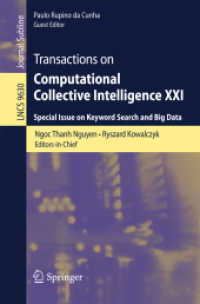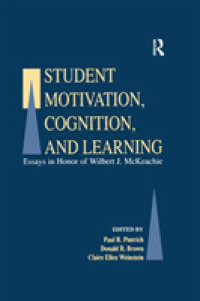Full Description
This multidisciplinary book shows how to foster meaningful relationships between therapists and vulnerable children, through exploring the concept of communicative musicality and creating rhythms of connection.
It includes broad and in-depth contributions from leading therapists from diverse backgrounds - including Peter A. Levine, Daniel Hughes, Stephen Porges, Dennis McCarthy and many more. Contributors reflect on their own experiences, providing insights from the fields of music therapy, trauma, dance and movement therapy, psychobiology, dramatherapy, counselling, play therapy, and education. Contemporary theory is woven in with case stories to highlight the emotional realities of working with highly vulnerable children, and to present proven examples of how therapists can improve the quality of connectedness. Full of original and innovative ideas for working with attachment issues, trauma, communication difficulties, autism, learning disabilities, aggression and anxiety, this is inspiring reading for professionals who work with vulnerable children in creative therapies.
Royalty proceeds from the book will be donated to the National Society for the Prevention of Cruelty to Children (NSPCC), UK.
Contents
Introduction. Rhythm from the Beginning. Stuart Daniel, Play Therapist, Spectrum Integrated Play Therapy, UK and Colwyn Trevarthen, Professor Emeritus of Child Psychology and Psychobiology, University of Edinburgh, UK. Part One. The Musical Essence of Human Connection. 1. Love, Rhythm and Chronobiology. Nigel Osborne. 2. Health and Happiness Grow in Play: Caring for Intimate, Musical Vitality from Birth. Colwyn Trevarthen. Section Two. 3. 'I'm Right Here, Little One': A New Mother's Reflections on Dance Movement Psychotherapy. Carolyn Fresquez, Dance Movement Psychotherapist, New Mexico, USA. 4. Establishing a Therapy of Musicality: The Embodied Narratives of Myself with Others. Stephen Malloch, Director, HeartMind & Associates, Sydney, Australia and Researcher, Westmead Psychotherapy Program, Sydney Medical School, Sydney University. 5. Finding Our Way to Reciprocity: Working with Children Who Find it Difficult to Trust. Dan Hughes, Clinical Psychologist, Quittie Glen Center for Mental Health, Annville, Pennsylvania, USA. 6. From Cocoon to a Butterfly: Music Therapy with an Adopted Girl. Cochavit Elefant, Music Therapist, Head of Graduate School for Creative Arts Therapies, University of Haifa, Israel. 7. Play and the Dynamics of Treating Medical Trauma: Insights from Polyvagal Theory. Stephen Porges, Research Professor, Department of Psychiatry, University of North Carolina, USA and Stuart Daniel. 8. Somatic Experiencing: A Body Oriented Approach to the Treatment of Traumatized Infants and Children. Peter Levine, PhD, Founder, The Somatic Experience® Trauma Institute, Boulder, Colorado, USA. 9. Finding Togetherness: Musicality in Play Therapy with Children with Severe Communication Difficulties. Stuart Daniel. 10. Harnessing the Dragon: Using an Image of Unbridled Life Force in Play Therapy. Dennis McCarthy, Mental Health Counsellor and Play Therapist, Director of the Metamorfos Institute, New York, USA. 11. The Lost and Found: Helping Children through Emotional Trauma Using Neurocellular Developmental Movement Methods. Katy Dymoke, Dance Movement Psychotherapist, Director of the BMC program, UK. Embody-Move and Touchdown Dance. 12. Relating when Relating is Hard: Working with Aggression in Play Therapy. Dee Ray, Distinguished Teaching Professor, Director of the Child and Family Resource Clinic, University of North Texas, USA. 13. The Rhythms of an Oily Cart Show: Theatre for Young People with Complex Learning Disabilities. Tim Webb, Artistic Director and CEO, Oily Cart. 14. A Meaningful Journey: Including Parents in Interactive Music Therapy Children at Risk. Stine Lindahl Jacobsen, Associate Professor, Head of MA Music Therapy Programme, Aalborg University, Denmark. 15. Noise, Time and Listening: Enabling Children to Express Themselves through Music. Hugh Nankivell, Composer and Musician, BSO Music Associate for Devon, UK and Sarah Butler, Early Years Leader, Haytor View Community Primary School and Nursery, UK. 16. A Voyage into the Seascape: Dramatherapy in Education. Penny McFarlane, Dramatherapist/Supervisor, UK. 17. Establishing Relationships with Children with Autism Spectrum Disorders through Dance Movement Psychotherapy: A Case Study Using Artistic Enquiry. Foteini Athanasiadou, Dance Movement Psychotherapist, UK and Vicky Karkou, Dance Movement Psychotherapist and Professor, Department of Performing Arts, Edge Hill University, UK. 18. Collective Musicality: Stories of Healing from the Companhia de Música Teatral and other Arts Projects. Helena Rodrigues, Laboratory of Music and Communication in Infancy, New University of Lisbon, Portugal and Companhia de Música Teatral and Paulo Rodrigues, Department of Communication and Art, University of Aveiro, Portugal and Companhia de Música Teatral. 19. Moving Freely to Music: A Child-Centred Research Practice in Early Years. Ana Almeida, Researcher, Institute for Music in Human and Social Development, ECA, University of Edinburgh, UK. 20. Seeing the Play in Music Therapy and Hearing the Music in Play Therapy for Children Receiving Medical Treatment. Jane Edwards, Associate Professor of Mental Health, Deakin University, Victoria, Australia and Judi Parson, Senior Lecturer in Mental Health, Deakin University, Victoria, Australia. 21. And then I Belonged: Relational Communication Therapy in a Remote Tanzanian Orphanage. Chantal Polzin, Teacher (Special Educational Needs) and Researcher, BabyLab Hannover, Leibniz University, Hannover, Germany, Ulrike Lüdtke, Professor and Head of Department, Speech and Language Pedagogy and Therapy and BabyLab Hannover, Leibniz University, Hannover, Germany, Josephat Semkiwa, Lecturer for Special Needs Education and Researcher, Sebastian Kolowa Memorial University, Tanzania, and Bodo Frank, Researcher/Co-director BabyLab Hannover, Leibniz University, Hannover, Germany.








